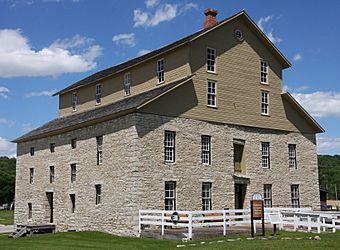Painter-Bernatz Mill facts for kids
Quick facts for kids |
|
|
Painter-Bernatz Mill
|
|

The mill in 2017
|
|
| Location | 200 N. Mill St. Decorah, Iowa |
|---|---|
| Built | 1851 |
| Built by | William Painter |
| NRHP reference No. | 74000816 |
| Added to NRHP | January 11, 1974 |
The Painter-Bernatz Mill, also known as the Old Stone Mill, is a very old and important building in Decorah, Iowa, United States. It was built a long time ago and used to grind grain into flour. Today, it's part of a museum, showing how people lived and worked in the past. This historic mill is the oldest building in Decorah.
Contents
The Historic Painter-Bernatz Mill
The Painter-Bernatz Mill has a rich history. It was first built in 1851 by William Painter. Over the next year or two, the mill was made even bigger. The bottom two floors of the building are made from strong, natural limestone found nearby.
How the Old Mill Worked
For many years, the mill used the power of water to operate. A special channel, called a mill race, was built from a dam on the Upper Iowa River. This channel directed water right under the building. The flowing water turned a turbine, which then powered the mill's machinery. This mill was the first of at least 15 mills that used the Upper Iowa River for power.
The original roof of the mill was a "hip roof." But sometime between 1874 and 1890, this was changed. A new "gable roof" was built, which created a large open space called a loft inside the mill.
From Water Power to Diesel
The mill continued to use water power for a long time. However, in 1947, things changed. Diesel engines took over from water power to run the mill. The building kept working as a mill until 1964.
The Mill Today: A Museum and Heritage Site
In 1971, the Painter-Bernatz Mill became part of the Vesterheim Norwegian-American Museum. Now, it's not grinding grain anymore. Instead, it holds interesting exhibits about farming and industry from the past. It helps visitors understand how people used to live and work.
The mill is also an important spot in the Silos & Smokestacks National Heritage Area. This area helps tell the story of agriculture in America. Because of its historical importance, the Painter-Bernatz Mill was added to the National Register of Historic Places in 1974.



